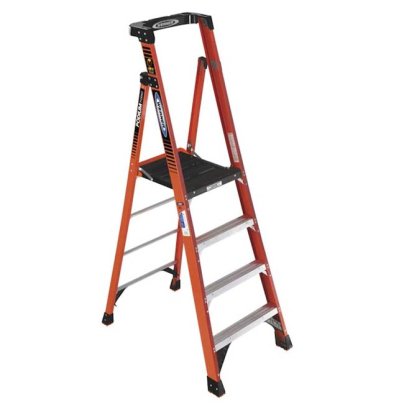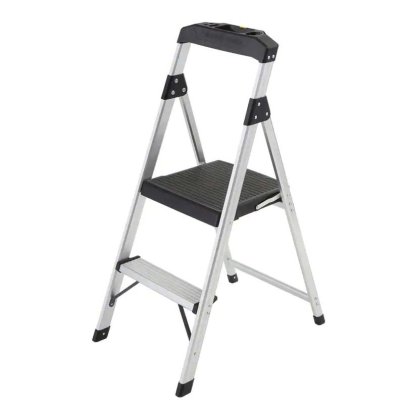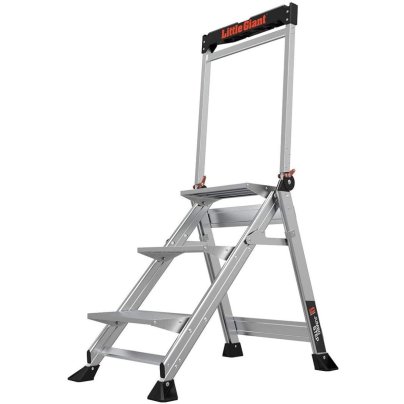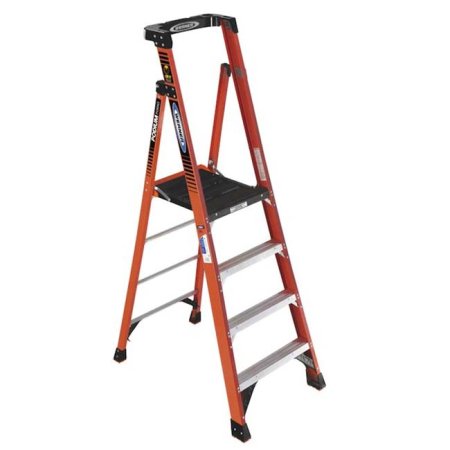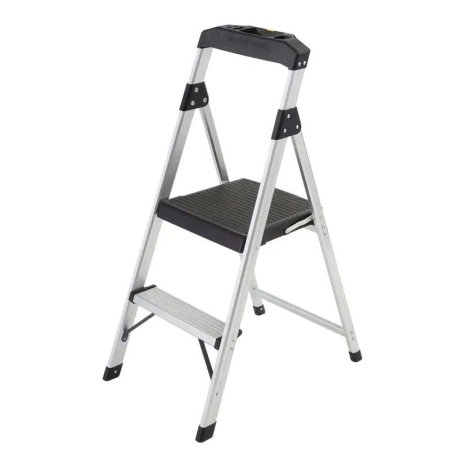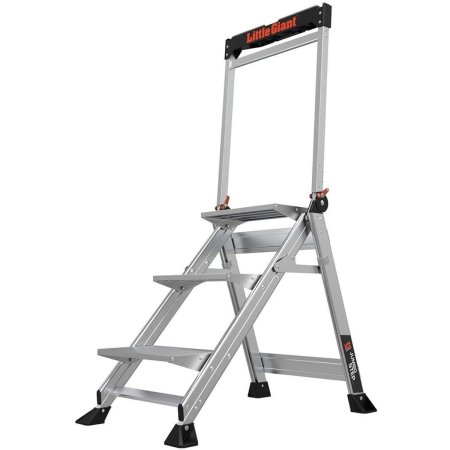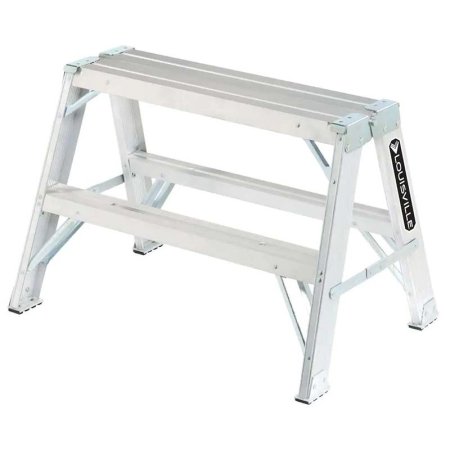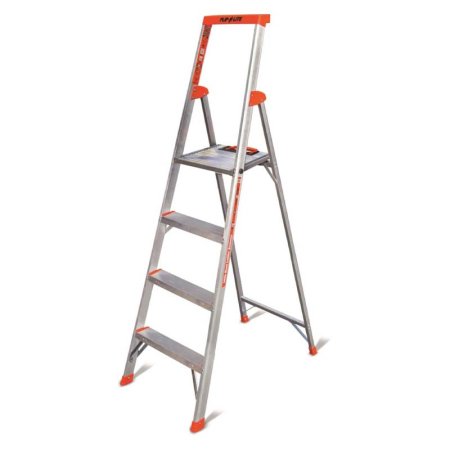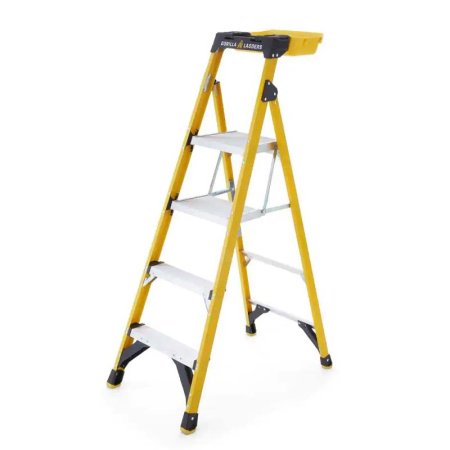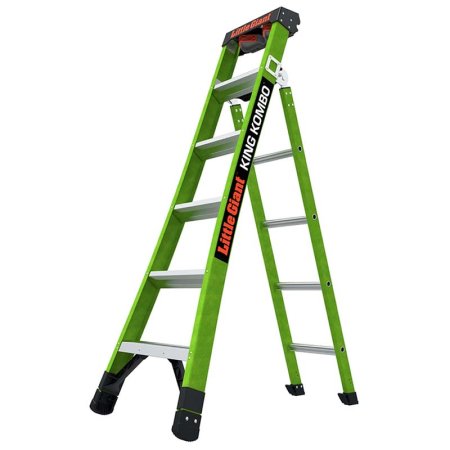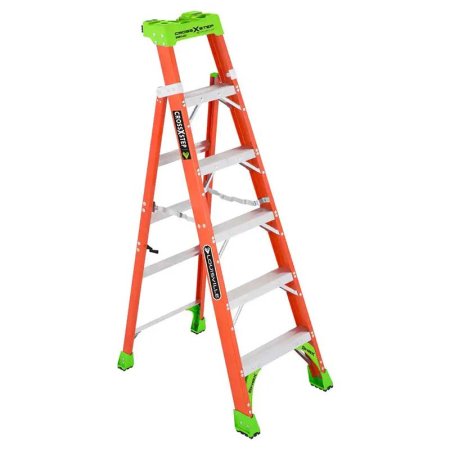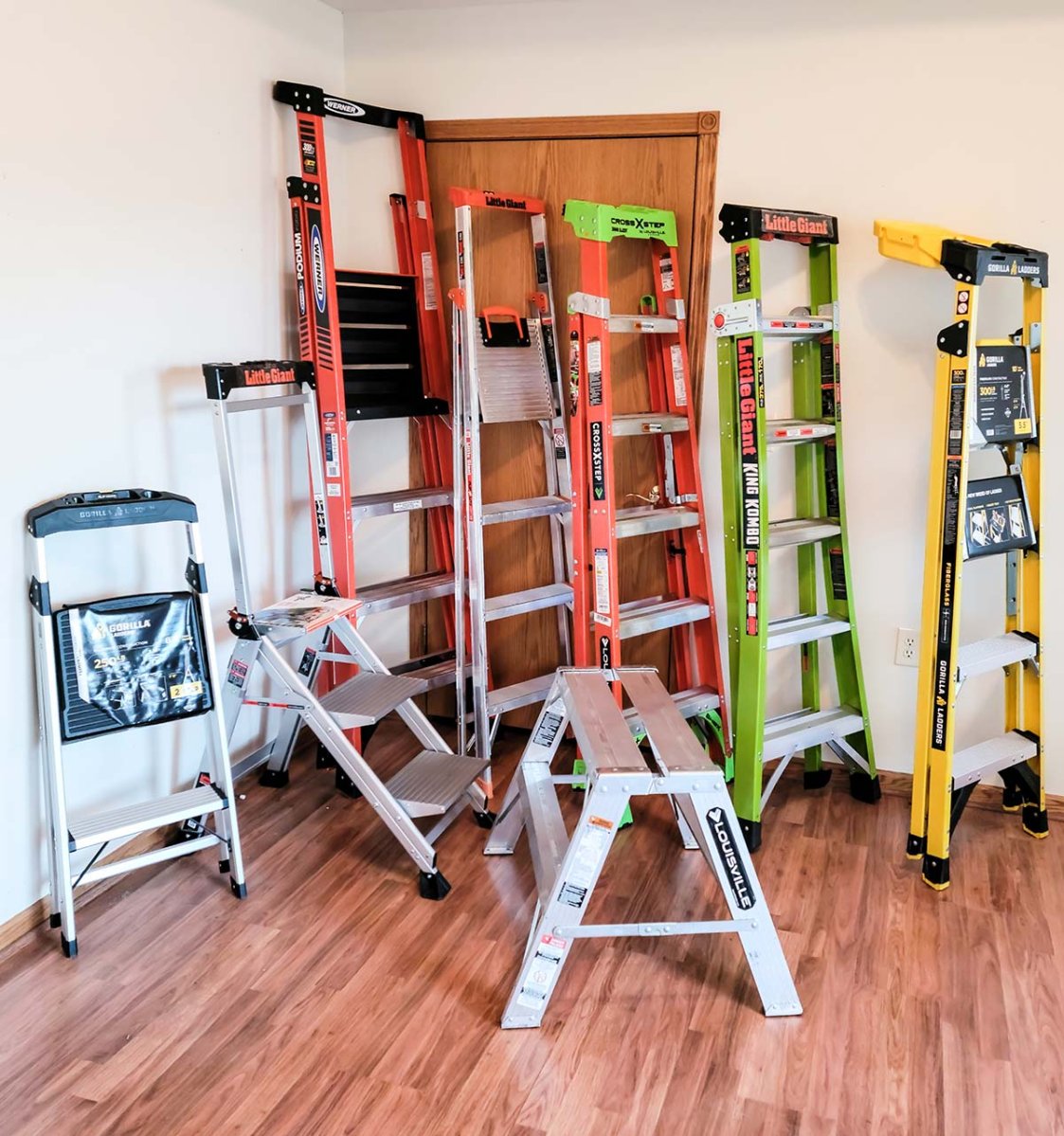
We may earn revenue from the products available on this page and participate in affiliate programs. Learn More ›
From tucking away totes on top shelves in the closet to cutting in paint edges along the top of a wall, a step ladder is the tool of choice for accessing difficult-to-reach areas. But not all step ladders are created equal. The best step ladders are durable, capable of safely supporting your weight (plus any tools and materials you’re carrying), and sturdy enough not to slip, tilt, or waver while standing on them.
Furthermore, some ladders are better suited for specific tasks and projects than others. We wanted to know what sets the top ladders apart from the rest of the pack, so we decided to test them. We selected step ladders from leading ladder manufacturers Little Giant, Werner, and Louisville, and we tested them for stability, safety, ease of use, and quality.
If you’re in the market for a step ladder, keep reading to discover how the following models earned a spot on our lineup of the best step ladders and find out what we loved—and didn’t like so much—about each one.
- BEST OVERALL: Werner 4-Foor Fiberglass Platform Ladder Type IA
- BEST BANG FOR THE BUCK: Gorilla Ladders 2-Step Aluminum Step Stool Ladder
- BEST FOR DAILY USE: Little Giant 3-Step Jumbo Step
- BEST HANDS-FREE: Louisville Ladder 2-Foot Aluminum Sawhorse Ladder
- BEST LIGHTWEIGHT: Little Giant Flip-N-Lite Aluminum Ladder
- BEST DUAL-PLATFORM: Gorilla Ladders Fiberglass Dual Platform Ladder
- BEST EXTENDABLE: Little Giant King Kombo Professional Ladder
- ALSO CONSIDER: Louisville Ladder 6-Foot Fiberglass Cross Step Ladder
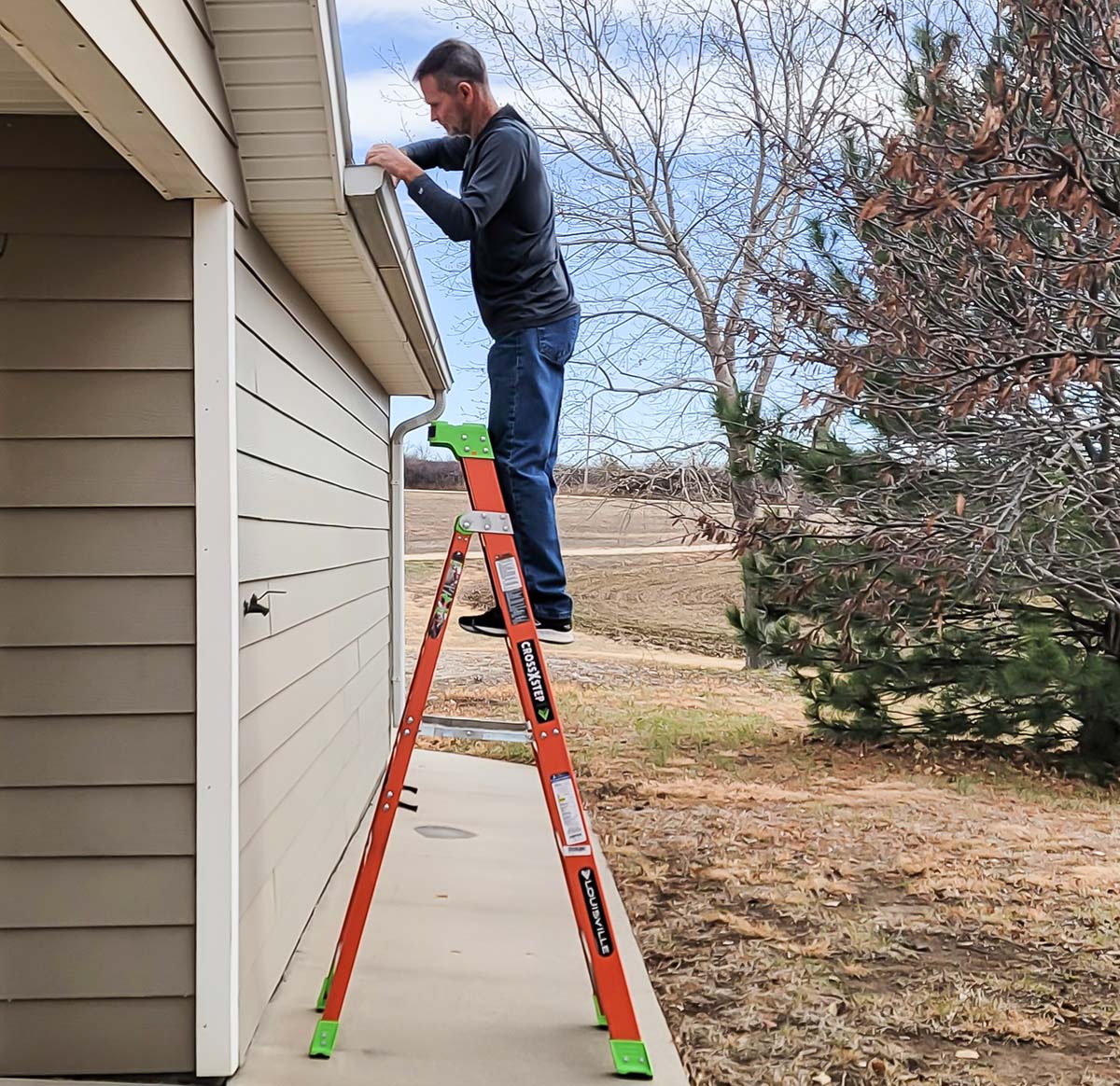
How We Tested the Best Step Ladders
We researched the most sought-after step ladders and step stools in their respective categories, considering type, materials, weight capacity, height, safety features, and other special features before selecting the models we wanted to test. In all, we researched more than 35 different models. Our goal was to test a variety of models and types, including standard A-frame step ladders, leaning step ladders, platform models, and even extension ladders to ensure we were looking at as many types as our readers would be.
All step ladders will elevate the user, but tasks vary from painting kitchen cabinets to cleaning out gutters—and the ladder chosen should fit the project. We considered brands to a large extent when choosing the ladders to test. Little Giant, Werner, and Louisville Ladders are tops in the industry, and since safety is our top priority, we didn’t select cheaper models.
For the actual testing, we noted how easy/difficult it was to set up and use each ladder, and we looked for little extras that make tasks easier, such as tool trays, platform steps, and curved safety rails for added maneuverability.
Then the physical part of the testing started. We set up each step ladder and hopped on. Literally, we hopped and bounced on the steps to determine sturdiness. We climbed to the uppermost steps, twisted, turned, and came down backward. We moved the ladders into various spots on different surfaces—carpeting, hard flooring, gravel, and concrete—and repeated the tests. We folded and unfolded the ladders and carried them around to see how portable they were. We also shoved them around a bit when they were on hard flooring (laminate) to see if they would slide or grip the floor.
During the testing process, we awarded points via a rubric. The better a ladder performed on a test, the higher the points it earned. After testing, we added the points and used them to designate the most suitable category for each ladder.
Our Top Picks
To qualify for a spot on this lineup of the best step ladders, each model had to be straightforward to use and sturdy. We tried out each function and accessory on every ladder and inspected and analyzed its overall design. The following step ladders offer a range of climbing solutions; some are better suited to specific tasks than others. Shoppers will want to find out the pros and cons we discovered in our hands-on tests before choosing the best one for their needs.
Best Overall
Werner 4-Ft. Fiberglass Platform Ladder Type IA
Pros
- Very stable and offers a large platform or tool tray for standing and accessories
- Features a top rail that holds a variety of tools and materials
- Nonslip rubber feet keep it from sliding on slick floors
Cons
- Isn’t designed to support a paint roller tray
Product Specs
- Ladder rating: Type 1A
- Top step height: 4 feet (10-foot reach)
- Weight capacity: 300 pounds
For pros and enthusiastic DIYers, it’s tough to beat the stability we found in the Werner 4-foot step ladder. This professional-grade step ladder, made from high-quality fiberglass, is very sturdy in actual use. It opens easily and locks into the open position to prevent it from accidentally collapsing, and it has rubber feet to keep it from sliding. It features an oversize platform in place of a fourth step, which allowed us to stand comfortably and safely with both feet and even turn around thanks to the top safety rail that curves outward, providing additional standing space.
The top rail features a series of holders and cups for stowing tools and materials, such as hammers, drills, nails, and screwdrivers. We found the tool rail exceptionally handy, as we know how much time is wasted climbing up and down a ladder to fetch different tools. This Type IA step ladder will hold up to 300 pounds. We especially appreciated the nonslip feet that didn’t slide—even on a slick floor.
The only notable downside is the ladder’s inability to support a standard paint roller tray, which means we’d still have to climb up and down if painting with a roller overhead. Not all step ladders have roller tray support, but given that this is a prograde choice, we think it should include the option. That aside, we consider this a top-notch ladder well suited for construction, remodeling, and DIY projects where the user needs a sturdy platform from which to work. It weighs 26.7 pounds—heavier than some—but is still lightweight enough to carry around a house or jobsite.
Get the Werner step ladder at The Home Depot or DSL Supply.
Best Bang for the Buck
Gorilla Ladders 2-Step Aluminum Step Stool Ladder
Pros
- Lightweight at just 6.4 pounds, this ladder is portable and versatile
- Folds up easily by lifting the back of the platform, making it simple to close and carry using just 1 hand
- Top rail has holders for a few hand tools or a paint cup
Cons
- At just 6.4 pounds, the step ladder doesn’t offer enough weight to keep it from tipping if the user leans over
Product Specs
- Ladder rating: Type I
- Top step height: 2.17 feet
- Weight capacity: 250 pounds
Those looking for a foot-up from a step ladder without spending a lot will want to check out Gorilla Ladders’ two-step model made from lightweight, durable aluminum. This budget-friendly choice is just the ticket for household use.
We were impressed by the firmness of this little aluminum ladder, given that it only weighs 6.4 pounds. It folds out easily and locks in the open position to prevent it from accidentally folding up during use. We liked that the upper step is a platform that offers added room for standing with both feet. The ladder folds easily just by lifting the upper platform’s back side, making it super easy to fold with just one hand.
The rail at the top of the ladder provides additional security, and we found it easy to lean our legs against it for added balance while reaching overhead with both hands to access top shelves.
It includes nonskid feet, and the upper safety rail has holders for a few tools or a handled paint cup. However, we don’t consider this two-step ladder a jobsite pick, even though it has a load capacity of 250 pounds and is rated Type I. It’s handy, offering up to 8.17 feet of reach for most users, but because it’s lightweight, it might pose a tipping problem for construction pros that tend to lean to one side or another. This is best suited for household use and occasional overhead or DIY projects such as changing a lightbulb or retrieving a box from a high shelf.
Get the Gorilla Ladders 2-Step step ladder at The Home Depot.
Best for Daily Use
Little Giant Jumbo Step, 3-Step Model
Pros
- Nonslip treads are built into the steps to reduce the risk of slipping
- The oversize rubber-tipped feet keep it from slipping on hard flooring
- Safety rail features several holders for tools, fasteners, and even a cell phone, if desired
Cons
- Pricey
- Safety rail is hinged for easy storage but creates a weak point that may eventually wear out and allow the rail to collapse
Product Specs
- Ladder rating: IAA
- Top step height: 2.2 feet
- Weight capacity: 375 pounds
For projects that require climbing up and down a step ladder often, the Little Giant Jumbo Step will make the tasks safer and more accessible.
The Jumbo Step offers enhanced safety benefits. We liked its stairlike steps that aren’t as steep as traditional step ladders, and each step has nonslip treads to prevent slipping. The extended tripod design makes this steel-frame step ladder one of the most stable we tested, and its rubber-tipped feet held firmly and didn’t slide. The ladder opens easily and features hinge locks that keep it from closing unexpectedly.
One thing that’s different about the aluminum Jumbo Step is its fold-up safety rail. It comes with the rail folded down along the legs of the ladder, but we found it simple to fold up and snap into place. While this feature makes the ladder more compact for storage, we think the hinge is a weak spot. Most step ladder safety rails are a solid extension of the ladder’s back legs. With a hinged rail, there’s the potential for the hinge to fail. Still, during testing, the hinge functioned securely.
The Little Giant Jumbo Step is rated with a load capacity of up to 375 pounds (Type IAA), and we found its overall step design very stable. We could stand and even bounce without any movement or shifting of the ladder. It has oversize nonslip rubber feet, and the safety rail boasts several cups and holders for stowing small tools and materials.
We would recommend this ladder to anyone who wants the added security of less-steep steps and a strong base, but we wouldn’t depend on the safety rail to support the entire leaning weight of a large individual. We’d lean as little as possible and use the rail for hand support when climbing up and down the steps.
Get the Little Giant Jumbo step ladder at Amazon, Ace Hardware, or Lowe’s.
Best Hands-Free
Louisville Ladder 2-Ft. Aluminum Sawhorse Ladder
Pros
- Tripod design of this step ladder makes it stable and sturdy; collapses for easy storage
- Angle braces under the top platform; lower steps add stability
- Can double as a sawhorse for supporting boards or other items
Cons
- There is no safety grab rail, which may be a consideration for those with balance issues
- Locking hinges were stiff, requiring turning the ladder over and exerting pressure to release them for folding up the ladder
Product Specs
- Ladder rating: Type IA
- Top step height: 2.1 feet
- Weight capacity: 300 pounds
Folks who go up and down a couple of steps frequently can’t use their hands for support when both hands are full, carrying the likes of a drywall taping trowel and a large tray of joint compound. The all-aluminum Louisville Ladder two-step ladder solves that problem by providing a sturdy tripod-type ladder that can be climbed from either side. The step stool also doubles as a sawhorse.
Since we often find it necessary to go up and down short ladders with full hands while hanging wallpaper, painting, or performing other tasks, we fell in love with this little Louisville Ladder step stool. It’s not for someone who has difficulty balancing when standing or climbing, however, because it offers no safety rail to grab or lean on. Still, the broad second step, which serves as a work platform, allowed us to move around freely.
The standing platform is 2.1 feet high, which gave us an approximate 8-foot reach. The legs on this step stool fold out quickly, and locking side bars keep them from accidentally closing. The Louisville also has added angle braces under both side steps for increased safety. This little platform step ladder will hold up to 300 pounds and comes with nonslip foot pads. The only downside we ran into was folding the ladder up: The locking hinges were so stiff, we had to turn the ladder upside down and push directly on the underside of the hinges to close the legs. These could loosen up some with use, however.
Get the Louisville Ladder 2-foot step ladder at The Home Depot or Grainger.
Best Lightweight
Little Giant Flip-N-Lite Aluminum Ladder
Pros
- Lightweight and portable, this step ladder is easy to carry
- Safety rail features a tool tray for holding hand tools and materials
- Easy to close by simply lifting a handle at the back of the platform step
Cons
- Nonslip feet slid slightly when the ladder was pushed on hard flooring
Product Specs
- Ladder rating: Type IA
- Top step height: 3.7
- Weight capacity: 300 pounds
The Little Giant Flip-N-Lite aluminum step ladder is designed for heavy-duty commercial or rugged DIYer use. It is duty-rated Type IA to support up to 300 pounds of load capacity. Sturdy aluminum rails, aluminum steps, and edge bracing add solid support to this versatile ladder. This lightweight step ladder weighs only 14 pounds, and we found the Flip-N-Lite simple to use and very portable. It folds out quickly, and the top platform step snaps into place, which locks the step ladder in position so it doesn’t inadvertently collapse during use.
Folding it up is super simple—the back of the platform step comes with a handle—and all we had to do was lift the handle to unlock the ladder and fold it. The Flip-N-Lite has nonslip feet, but we found they didn’t grip hard flooring (laminate) as well as some of the other ladders we tested. Maybe because this is such a lightweight ladder, but when we pushed it—we got a little slide across the floor. When we stood on it and bounced, however, it seemed stable.
This lightweight step ladder is well suited for anyone who needs to move a ladder around the house or jobsite or has to lift it to the bed of a pickup truck. It doesn’t boast many bells and whistles, but it’s stable and portable.
Get the Little Giant Flip-N-Lite step ladder at Acme Tools, Lowe’s, or Industrial Ladder & Supply Co.
Best Dual-Platform
Gorilla Ladders Fiberglass Dual Platform Ladder
Pros
- Ladder folds out and folds up easily
- 2 standing platforms add stability when working at heights
- A detachable project bucket provides room to hold power tools or even a 1-gallon bucket of paint
Cons
- Ladder is slightly less stable when working from the upper platform, but should pose no problem for a seasoned worker.
Product Specs
- Ladder rating: Type IA
- Top step height: 3.75 feet
- Weight capacity: 300 pounds
Platform steps are showing up on many new step ladders, and for good reason—they allow the user to stand on a more spacious surface, making it safer to work overhead. We like that Gorilla included two platforms on its four-step fiberglass step ladder because it allowed us to stand securely at different heights.
The ladder folds out quickly, and the upper platform locks into place along the rear legs. Folding it back up is as simple as lifting the back of the platform, which releases the locking mechanism. In addition to a safety rail that features several tool holders, this model also comes with a project bucket that snaps onto the safety rail and is sturdy enough to hold a full-gallon paint can or heavier tools. When not in use, the project bucket attaches to the back legs of the ladder, where it doesn’t take up extra room when the ladder is folded.
We found the ladder stable and sturdy when climbing and working off both platforms, although it was slightly less stable when we bounced on the top platform. That’s to be expected since the upper platform is near the top of the ladder—a spot higher than considered safe for standing on most step ladders. Still, we felt the Gorilla ladder was safe for confident users working at heights. We’d suggest working from the lower platform for those who are tentative when climbing ladders. This Type IA ladder is designed with a weight capacity that can support up to 300 pounds safely.
Get the Gorilla Ladders dual platform step ladder at The Home Depot.
Best Extendable
Little Giant 13906-002 King Kombo Professional Ladder
Pros
- The extension feature on this step ladder allows the user to reach taller heights
- Sturdy base, nonslip rubber feet, and quality construction make the King Kombo sturdy and stable
- At 22 pounds, it’s still light enough for most pros and DIYers to carry without too much effort
Cons
- The ladder is expensive
- Rather than telescoping by the back step section sliding along the front section, the ladder extends by folding out the back section of steps and then folding them upward, which requires a spacious area
Product Specs
- Ladder rating: Type IA
- Top step height: 4.3 feet
- Weight capacity: 375 pounds
Typically, a ladder is either a step ladder, a leaning ladder, or an extension ladder, but Little Giant’s King Kombo is all three. By releasing a lever located at the back of the top step, it was easy for us to switch quickly from a step-ladder configuration to a 6-foot leaning ladder or a 10-foot extension ladder. In addition to all that versatility, the King Kombo is Type IAA rated and boasts the ample weight capacity of up to 375 pounds, although it weighs just 22 pounds.
This multiposition step ladder eliminates the need for three separate ladders when completing various overhead tasks. We found the King Kombo to be stable and sturdy in all positions. Still, if we had our druthers, we would opt for the extension movement to mimic other extension ladders, where the telescoping portion slides upward and locks in place. On the King Kombo, the back ladder legs fold out and then upward, requiring a large space to maneuver the ladder.
The front side of the ladder features wide flared legs for sturdy support, and the rear legs are narrower—they fit between wall studs or ceiling trusses for easy access to tight work spaces. The nonslip rubber feet are very secure and resisted our attempts to slide the ladder across hard flooring.
Get the Little Giant King Kombo step ladder at Ace Hardware, Lowe’s, or Zoro.
Also Consider
Louisville Ladder 6-Ft. Fiberglass Cross Step Ladder
Pros
- Top rail has an accessory tray that holds several large and small tools and supplies
- Nonslip feet on this ladder held firmly when we tried to push it across hard flooring
- The back side of the safety rail supports the ladder in a leaning position against a flat wall and on an outside corner
Cons
- The first ladder we tested was wobbly—but a replacement proved stable and sturdy
Product Specs
- Ladder rating: Type IA
- Top step height: 3.75 feet
- Weight capacity: 300 pounds
One of the first things we noticed about the 6-foot Louisville Cross Step ladder was that the back side of the safety rail was designed in an inverted “V” shape and featured rubber bumpers. This is a leaning step ladder, meaning it’s designed not to slip when leaned against a wall. The V-shaped inset also makes this ladder safe for leaning against outside wall corners—and it didn’t slip to either side or rock when we positioned it against a corner and climbed on. It was just as stable when we leaned it against a flat wall and did not slide to either side, even when we bounced on the steps.
The step ladder also has nonslip feet to prevent it from sliding across hard flooring. It’s Type IA rated, meaning it has a weight capacity of up to 300 pounds. We liked the large and small tool holders on the safety rail tray to accommodate a range of tools and supplies. However, we found the ladder wobbly when we opened it in step ladder mode, and we couldn’t stabilize it. Fortunately, our local The Home Depot store was happy to exchange it for another model, which was totally sturdy during all testing procedures, and so earned a spot on our lineup. We’re not sure why the first model wobbled, but we figured it might have gotten damaged or racked out of alignment during shipping.
Get the Louisville Ladder Cross step ladder at The Home Depot, Wayfair, or Zoro.
Jump to Our Top Picks
What to Consider When Choosing the Best Step Ladder
Unlike straight ladders—the type used to reach a roof or a gutter—traditional step ladders don’t lean against a wall for support. Instead, they fold open to form a pyramid shape, with four feet providing stability. Their steps are also broader and deeper than the rungs of a straight ladder.
For anyone needing a lift to retrieve something from a seasonal shelf in the pantry or install a rack on the wall, a step ladder will come in handy. Consider the following factors and features when shopping for the best step ladder.
Type
Among the handiest of tools, a step ladder will quickly earn its keep in a home when accessing items that are otherwise out of reach, hanging mirrors, or painting trim. Step ladders fold up to just a few inches thick, making many suitable for storage in a utility closet. The best folding step ladder options will keep users safe as they work—just be sure to choose the right type for the particular conditions and tasks required:
- A-frame: An A-frame is the classic step ladder. It is a freestanding ladder that looks like the letter “A” when viewed from the side. Specialized A-frames may feature a telescoping frame for use on stairs or ramps, or twin steps with steps on both arms of the “A,” allowing two workers to use the ladder at the same time.
- Leaning: Most step ladders are dangerous for use without opening the frame, but lean-safe step ladders are an exception to the rule. These models may be used either open or closed, giving them additional functional flexibility for DIY projects or professional tasks.
- Extension: Multiposition step ladders offer adjustability for different working heights. Extension ladders may feature telescoping legs, or one side of the ladder may be designed to fold upward to create a taller extension ladder.
- Platform: A platform ladder is a step ladder with a broad standing surface and a safety rail at the top. This configuration offers extra standing stability for projects such as overhead painting or cleaning windows.
Material
Step ladders are primarily made of four materials: aluminum, fiberglass, steel, and wood. Each has specific benefits.
- Aluminum: Step ladders made from aluminum are lightweight yet strong and durable, making them easy to carry and convenient to use. Aluminum doesn’t rust or corrode as quickly as steel, but it’s not entirely impervious to moisture, so don’t leave it out in the rain.
- Fiberglass: Electricians favor fiberglass step ladders because, unlike aluminum or steel, it won’t conduct an electrical current, making it safer to use when working near live wires. It’s even more robust than aluminum and nearly as lightweight, but it’s pricier. Fiberglass is also the most durable material for resisting rust and corrosion.
- Steel: Steel step ladders are durable and heavier than either aluminum or fiberglass, so they offer a sturdy base on which to climb. But steel also tends to corrode and rust if it gets wet, so use a steel ladder indoors if possible and wipe it dry if it gets wet.
- Wood: Before aluminum, fiberglass, and steel appeared in step ladders, wood was the material of choice. Wood step ladders are still available and often reasonably priced, but they may not support as much weight as other types of step ladders. Wood ladders tend to be less durable since they’re not weather-resistant, but purists tend to appreciate the vintage look of a wooden step ladder.
Height
Step ladders range in height from about 3 feet to 8 feet and usually feature three or more steps. The smaller version with just one or two steps is known as a step stool, and these may come with a support handle at the top the user can hold on to when stepping up. The user holds the ladder’s sides on a step ladder for support when climbing up or down. The ladder’s height should be measured from the ground to the highest usable step—not any part of the ladder’s frame or a rail that might extend higher. Not all sellers follow this rule, however, so read descriptions carefully.
If users must strain their arms, stand on tiptoe, or exceed the tallest climbable step to reach the desired height, the ladder is too short—with potential consequences ranging from minor discomfort to dangerous slips and falls. As such, it’s essential to consider reach height: the highest point a person can safely access while standing on the ladder. The reach height for step ladders is typically ladder height plus 6 feet. For instance, using a 3-foot step ladder, most adults can reach 9 feet. This will vary, of course, based on user height and arm length.
Weight Rating and Load Capacity
The American National Standards Institute (ANSI) rates step ladders by the amount of weight they will safely hold. Weight rating and load capacity are synonymous. The weight capacity will usually appear in the ladder’s description as maximum weight in pounds, such as “up to 250 pounds.” A ladder will also come with a duty rating, such as Type I, Type II, or Type III step ladder based on the following:
- Type IAA: safely supports up to 375 pounds
- Type IA: safely supports up to 300 pounds
- Type I: safely supports up to 250 pounds
- Type II: safely supports up to 225 pounds
- Type III: safely supports up to 200 pounds
Type I step ladders (including IA and IAA) are generally considered professional-grade ladders and are frequently used by trade and construction professionals. The “A” and “AA” signify high-quality materials that increase weight capacity and improve stability.
Type II step ladders are well suited for DIY use. They’re medium-duty ladders suitable for many jobs, such as overhead painting projects and light commercial use.
Type III step ladders are perfect for occasional use or household tasks, such as changing a light bulb in a ceiling light or retrieving items from upper shelves.
When determining the load capacity needed for a project, factor in the user’s own weight plus the weight of the tools and supplies needed to carry up or store on the ladder (if it has a built-in tray or shelf).
Safety
The majority of step ladders offer safe, long-lasting service when used as intended. In addition to noting the load capacity and duty rating, consider the material the ladder is made of and any special features. Fiberglass ladders are the best choice when working around electricity because they don’t conduct electricity, and those with slip-resistant treads are safer in wet conditions.
Think before setting up and climbing the ladder. Set it up on flat, level ground. Avoid working on a ladder in severe weather, high winds, and wet or icy conditions. Double-check that all hinges and adjustments are locked in place before climbing the ladder.
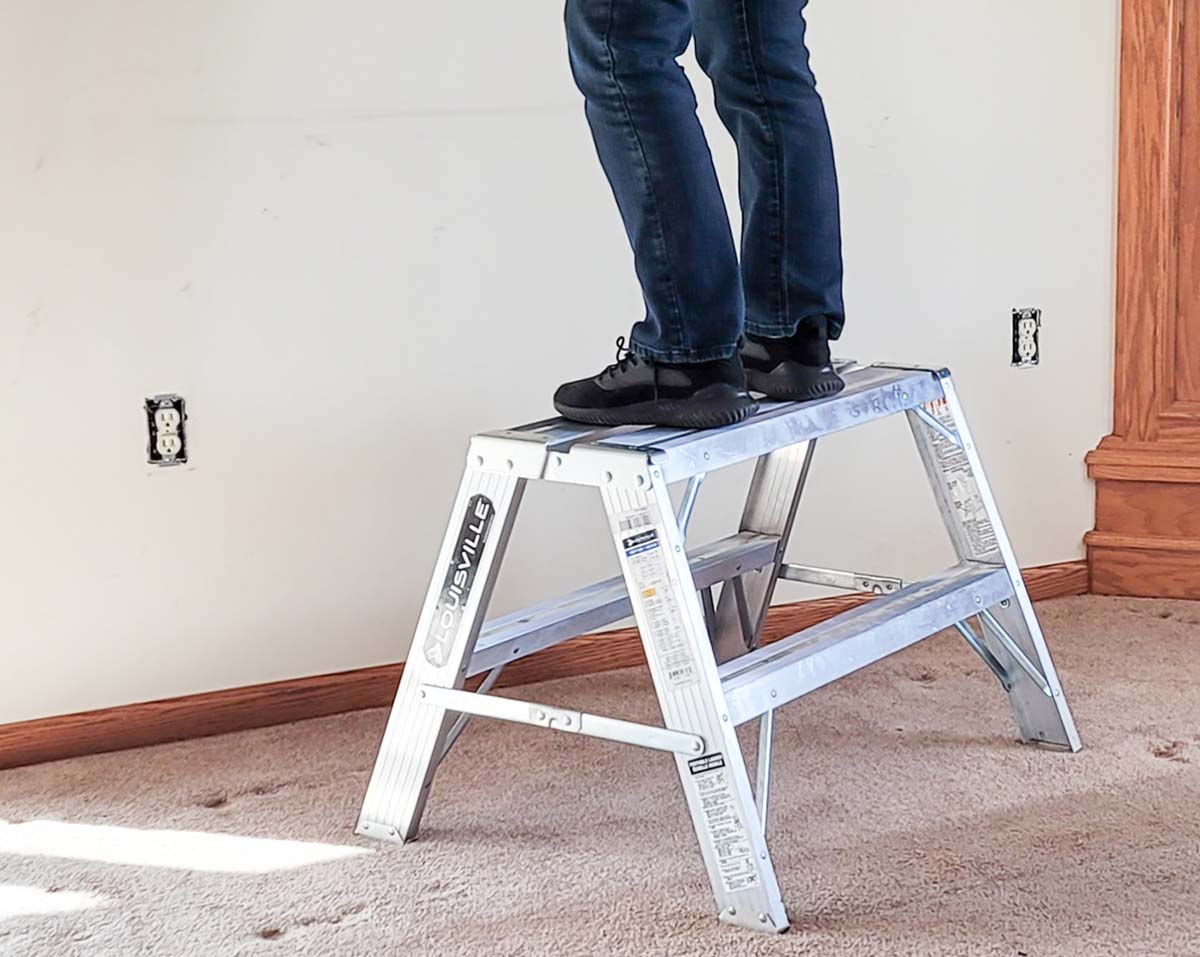
FAQs
For added safety, many of the step stools included in our list come with platforms for painting tools and cans, tool trays, nonslip or rubber feet, safety rungs, mar-resistant endcaps, rotating wall pads, and safety locking features. Step ladders are handy indoors and out, but first-time shoppers might still have a few questions.
Q. What is the difference between a Type 1 and Type 2 ladder?
ANSI rates ladders by the maximum amount of weight they can hold. Type 1 ladders can support 250 pounds; Type 2 ladders can safely support up to 225 pounds. Keep in mind that maximum weight load means all the weight on the ladder—for example, the weight of the user plus the weight of construction tools or paint tools.
Q. What is the safest step ladder?
The safest step ladders provide a sturdy working platform, support plenty of weight, and include additional features such as side rails to assist with ascending and descending.
Q. What is the highest rung I can go up on a step ladder?
The highest rung a user should ascend on a conventional A-frame step ladder is two rungs down from the top. The average maximum safe reach is about 4 feet above the top of the ladder.
Q. Which is better, an aluminum step ladder or a fiberglass step ladder?
Aluminum ladders are strong, lightweight, and weather-resistant. They are relatively inexpensive, resist corrosion, and are easy to set up. Fiberglass is even more durable than aluminum. It tends to be much stronger and more weather-resistant. Unlike aluminum, fiberglass is nonconductive, making it the superior choice for electrical projects.
Q. What angle should a ladder be when in use?
For safety purposes, a straight or extension ladder should slope at a 75-degree angle when in use. This rule doesn’t apply to step ladders because they do not lean against a wall.
Q. How do I keep a ladder from slipping?
Step ladders are less prone to slipping than other ladders thanks to their pyramidal shape, but they can still tip if placed on uneven ground. Before ascending a step ladder, make sure it’s stable (not wobbly) and that it’s on solid ground. Do not climb above the third rung from the top, and always face the ladder when climbing up or down.
